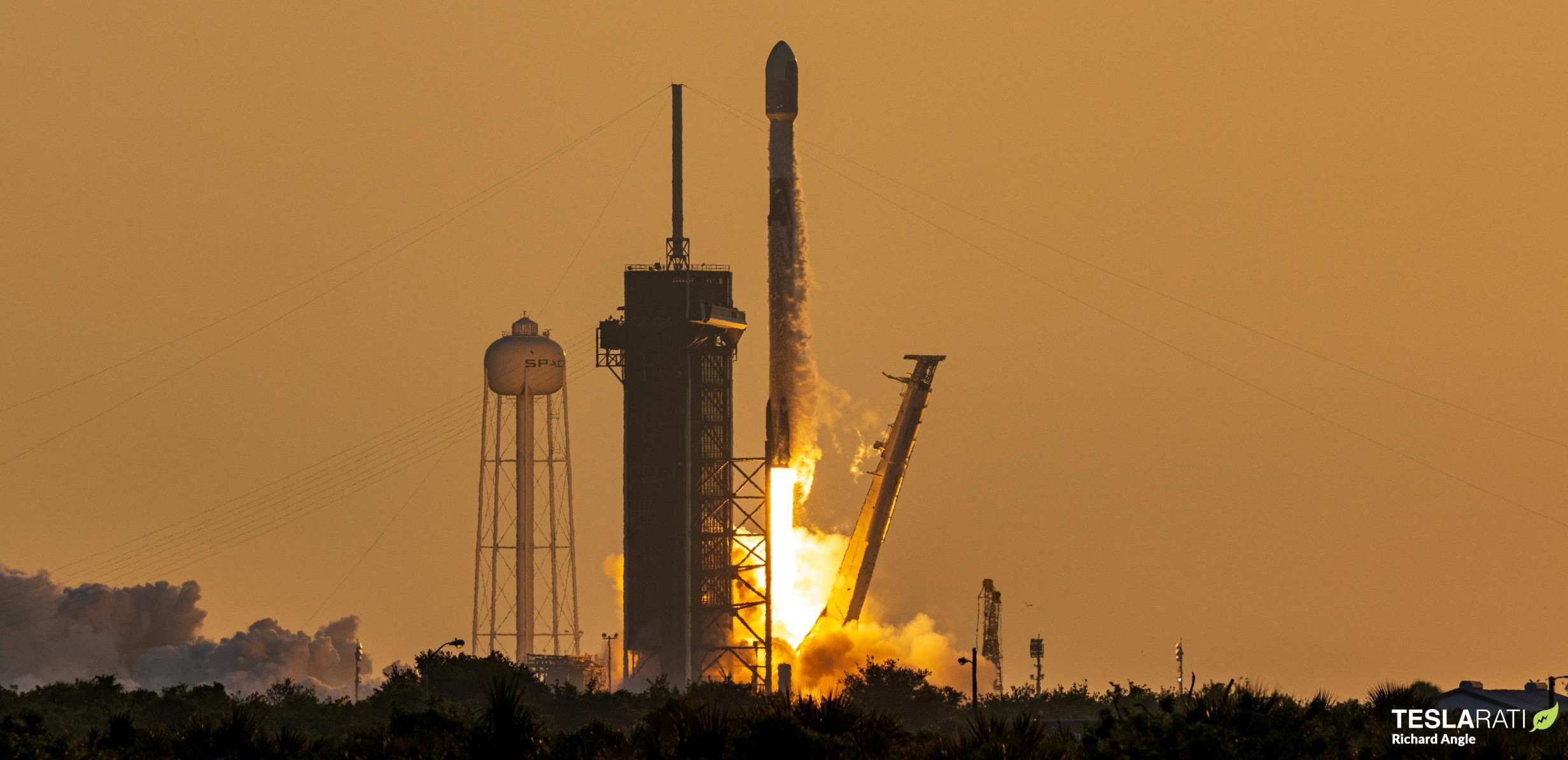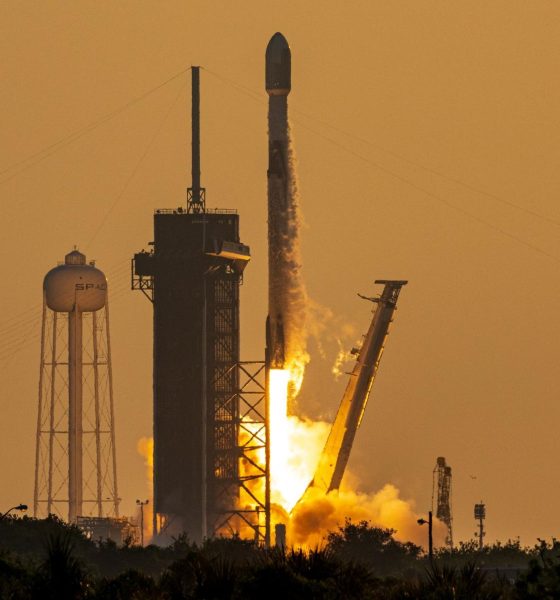SpaceX has completed its 21st Falcon 9 launch of 2022, continuing an impressive average cadence of more than one launch per week.
After an unexplained 40-minute delay from 6:20 am EDT, former Falcon Heavy booster B1052 lifted off from Kennedy Space Center Launch Complex 39A shortly after sunrise at 6:59 am EDT (10:59 UTC) on Wednesday, May 18th. Carrying its second batch of Starlink satellites on its third mission as a Falcon 9 boosters and fifth launch overall, Falcon B1052 performed flawlessly, safely carrying a reused Falcon fairing, expendable upper stage, and stack of 53 Starlink satellites most of the way free of Earth’s atmosphere.
B1052 then separated and coasted back to Earth as Falcon 9’s upper stage continued to orbit. About nine minutes after liftoff, the booster touched down on drone ship A Shortfall of Gravitas (ASOG) and the upper stage reached a safe parking orbit, marking the premature end of SpaceX’s official webcast. Starlink satellite deployment – typically anywhere from 20 to 60 minutes after liftoff – now occurs off-camera, with only a slight vocal confirmation and a tweet from SpaceX to verify the most important part of each mission.
Looking beyond the bounds of calendar years, Starlink 4-18 is SpaceX’s 28th successful launch since November 11th, 2021 – a period of six months and seven days or 27 weeks. In other words, SpaceX is already more than half of the way to demonstrating a sustained cadence of one launch per week over a full 12 months, leaving little doubt that the company has the ability to achieve CEO Elon Musk’s lesser goal of 52 launches in 2022. The company’s launch teams, processing facilities, launch pads, Falcon production, and fleets of reusable boosters and fairings have proven themselves fully capable.
The only remaining uncertainty stems from reliability and unknown unknowns. Even the most reliable rocket in the world is a highly complex system that can still fail in thousands of unique ways. After an impressive streak of 130 consecutively successful launch campaigns, Falcon 9 is by some measures the most reliable launch vehicle still in operation. As early as June 2022, however, Falcon 9 will have an opportunity to set the record for most consecutive successes of any rocket in history when it attempts to launch without fail for the 134th time in a row. For now, Russia’s R-7 or Soyuz family of rockets – which have launched close to 2000 times since 1966 – hold the current record of 133 consecutive successes. Technically, if one considers Falcon 9 and Falcon Heavy part of the same family, R-7/Soyuz and Falcon are now tied with records of 133 consecutive successes.
However, the differences between Falcon 9 and Falcon Heavy far exceed the relatively small differences between the many slight R-7/Soyuz variations. Given that the variants of Falcon 9 rockets that began SpaceX’s current streak of success in January 2017 were significantly different than those flying today, the full R-7/Soyuz family and Falcon 9 are more directly and fairly comparable than they might initially appear.

Regardless, SpaceX will have accomplished an extraordinary feat if Falcon 9 does complete its 134th successful launch in a row sometime next month. But simultaneously, R-7’s 133-launch record serves as a reminder that at one point in history, an entirely different rocket family that had been averaging more than one launch per week for almost a decade still failed after 133 successful launches. Modern airliners serve as another good reminder of the inherent instability of complex artificial mechanisms: even though they are statistically one of the safest forms of mass transit humans have ever created, they still occasionally crash.
To assume any such system has become immune to failure after a number of successes is to tempt fate. Nonetheless, with the qualification that there are no guarantees, SpaceX’s performance over the last five years significantly raises confidence in the company’s ability to continue executing and completing orbital launches at a rapid pace throughout 2022 (and beyond) without failure.
Beyond Starlink 4-18, SpaceX is scheduled to launch its own Transporter-5 rideshare mission as early as May 25th, Cargo Dragon’s CRS-25 space station supply mission on June 7th, Egypt’s Nilesat-301 communications satellite on June 10th, and a number of other unspecified commercial launches and Starlink missions in June and July.

Elon Musk
Elon Musk’s X will start using a Tesla-like software update strategy
The initiative seems designed to accelerate updates to the social media platform, while maintaining maximum transparency.

Elon Musk’s social media platform X will adopt a Tesla-esque approach to software updates for its algorithm.
The initiative seems designed to accelerate updates to the social media platform, while maintaining maximum transparency.
X’s updates to its updates
As per Musk in a post on X, the social media company will be making a new algorithm to determine what organic and advertising posts are recommended to users. These updates would then be repeated every four weeks.
“We will make the new 𝕏 algorithm, including all code used to determine what organic and advertising posts are recommended to users, open source in 7 days. This will be repeated every 4 weeks, with comprehensive developer notes, to help you understand what changed,” Musk wrote in his post.
The initiative somewhat mirrors Tesla’s over-the-air update model, where vehicle software is regularly refined and pushed to users with detailed release notes. This should allow users to better understand the details of X’s every update and foster a healthy feedback loop for the social media platform.
xAI and X
X, formerly Twitter, has been acquired by Elon Musk’s artificial intelligence startup, xAI last year. Since then, xAI has seen a rapid rise in valuation. Following the company’s the company’s upsized $20 billion Series E funding round, estimates now suggest that xAI is worth tens about $230 to $235 billion. That’s several times larger than Tesla when Elon Musk received his controversial 2018 CEO Performance Award.
As per xAI, the Series E funding round attracted a diverse group of investors, including Valor Equity Partners, Stepstone Group, Fidelity Management & Research Company, Qatar Investment Authority, MGX, and Baron Capital Group, among others. Strategic partners NVIDIA and Cisco Investments also continued support for building the world’s largest GPU clusters.
News
Tesla FSD Supervised wins MotorTrend’s Best Driver Assistance Award
The decision marks a notable reversal for the publication from prior years, with judges citing major real-world improvements that pushed Tesla’s latest FSD software ahead of every competing ADAS system.

Tesla’s Full Self-Driving (Supervised) system has been named the best driver-assistance technology on the market, earning top honors at the 2026 MotorTrend Best Tech Awards.
The decision marks a notable reversal for the publication from prior years, with judges citing major real-world improvements that pushed Tesla’s latest FSD software ahead of every competing ADAS system. And it wasn’t even close.
MotorTrend reverses course
MotorTrend awarded Tesla FSD (Supervised) its 2026 Best Tech Driver Assistance title after extensive testing of the latest v14 software. The publication acknowledged that it had previously criticized earlier versions of FSD for erratic behavior and near-miss incidents, ultimately favoring rivals such as GM’s Super Cruise in earlier evaluations.
According to MotorTrend, the newest iteration of FSD resolved many of those shortcomings. Testers said v14 showed far smoother behavior in complex urban scenarios, including unprotected left turns, traffic circles, emergency vehicles, and dense city streets. While the system still requires constant driver supervision, judges concluded that no other advanced driver-assistance system currently matches its breadth of capability.
Unlike rival systems that rely on combinations of cameras, radar, lidar, and mapped highways, Tesla’s FSD operates using a camera-only approach and is capable of driving on city streets, rural roads, and freeways. MotorTrend stated that pure utility, the ability to handle nearly all road types, ultimately separated FSD from competitors like Ford BlueCruise, GM Super Cruise, and BMW’s Highway Assistant.
High cost and high capability
MotorTrend also addressed FSD’s pricing, which remains significantly higher than rival systems. Tesla currently charges $8,000 for a one-time purchase or $99 per month for a subscription, compared with far lower upfront and subscription costs from other automakers. The publication noted that the premium is justified given FSD’s unmatched scope and continuous software evolution.
Safety remained a central focus of the evaluation. While testers reported collision-free operation over thousands of miles, they noted ongoing concerns around FSD’s configurable driving modes, including options that allow aggressive driving and speeds beyond posted limits. MotorTrend emphasized that, like all Level 2 systems, FSD still depends on a fully attentive human driver at all times.
Despite those caveats, the publication concluded that Tesla’s rapid software progress fundamentally reshaped the competitive landscape. For drivers seeking the most capable hands-on driver-assistance system available today, MotorTrend concluded Tesla FSD (Supervised) now stands alone at the top.
News
Elon Musk’s Grokipedia surges to 5.6M articles, almost 79% of English Wikipedia
The explosive growth marks a major milestone for the AI-powered online encyclopedia, which was launched by Elon Musk’s xAI just months ago.

Elon Musk’s Grokipedia has grown to an impressive 5,615,201 articles as of today, closing in on 79% of the English Wikipedia’s current total of 7,119,376 articles.
The explosive growth marks a major milestone for the AI-powered online encyclopedia, which was launched by Elon Musk’s xAI just months ago. Needless to say, it would only be a matter of time before Grokipedia exceeds English Wikipedia in sheer volume.
Grokipedia’s rapid growth
xAI’s vision for Grokipedia emphasizes neutrality, while Grok’s reasoning capabilities allow for fast drafting and fact-checking. When Elon Musk announced the initiative in late September 2025, he noted that Grokipedia would be an improvement to Wikipedia because it would be designed to avoid bias.
At the time, Musk noted that Grokipedia “is a necessary step towards the xAI goal of understanding the Universe.”
Grokipedia was launched in late October, and while xAI was careful to list it only as Version 0.1 at the time, the online encyclopedia immediately earned praise. Wikipedia co-founder Larry Sanger highlighted the project’s innovative approach, noting how it leverages AI to fill knowledge gaps and enable rapid updates. Netizens also observed how Grokipedia tends to present articles in a more objective manner compared to Wikipedia, which is edited by humans.
Elon Musk’s ambitious plans
With 5,615,201 total articles, Grokipedia has now grown to almost 79% of English Wikipedia’s article base. This is incredibly quick, though Grokipedia remains text-only for now. xAI, for its part, has now updated the online encyclopedia’s iteration to v0.2.
Elon Musk has shared bold ideas for Grokipedia, including sending a record of the entire knowledge base to space as part of xAI’s mission to preserve and expand human understanding. At some point, Musk stated that Grokipedia will be renamed to Encyclopedia Galactica, and it will be sent to the cosmos.
“When Grokipedia is good enough (long way to go), we will change the name to Encyclopedia Galactica. It will be an open source distillation of all knowledge, including audio, images and video. Join xAI to help build the sci-fi version of the Library of Alexandria!” Musk wrote, adding in a later post that “Copies will be etched in stone and sent to the Moon, Mars and beyond. This time, it will not be lost.”










